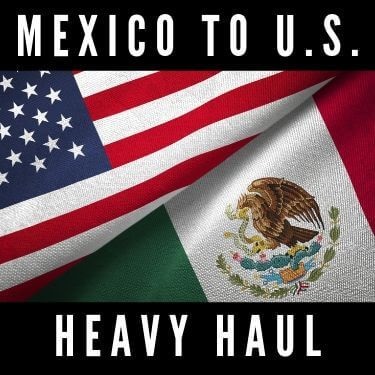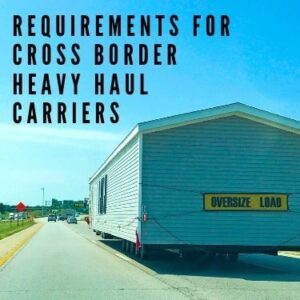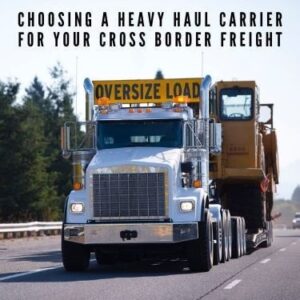
Por
 Copiar URL al Portapapeles
Copiar URL al Portapapeles
Managing Mexico to US heavy haul shipments can be a stressful process. With so much that could go wrong, it’s understandable if you’re starting to feel the pressure of a complex shipment. Shipping in and out of other countries is complicated enough, but trying to manage an oversized heavy haul shipment can really make things difficult. Thankfully, the process isn’t as difficult as it seems.
Shipping Mexico to US heavy haul freight will require strict adherence to many regulations. This includes regulations on when the heavy haul can be on the road, how it is displayed, and whether it needs an escort. Additionally, the DOT dictates that all heavy hauls require state permits for each state the shipment will move through.
Table of Contents
Heavy haul freight, sometimes called “oversized” freight, is a classification used to describe any freight that exceeds the size and weight restrictions that apply to normal freight. When large items cannot be broken down into smaller pieces to be shipped in parts, then the whole must be shipped all at once. This is called a “nondivisible load,” and it can provide some serious logistical difficulties to inexperienced shippers and carriers alike.
Some examples of Heavy Haul freight are:
However, those are not the only things that can be considered a heavy haul. Anything can fall under that classification, as long as it does not fit within the confines of a typical freight container, or it exceeds the size restrictions on normal shipments.
A Load is considered “heavy haul” in most states if it exceeds:
These dimensions are generally accepted, but it is important to remember that each state is going to be slightly different. Individual states determine the specific dimensions that qualify as oversized or heavy haul freight within their borders. What is considered an oversized load in one state might not be classified as such in another. Because of the complexity of the different state laws, most shippers choose to work with an experienced shipping and logistics company. This way, they can rest easy knowing that they will be compliant with all the required state laws.
When dealing with heavy haul trucking, it is important to remember that it takes a lot longer than normal truckload transportation services. This is because of a few reasons:
In addition to that, you might assume that because the countries are connected by land that the wait times are shorter than other imports, but that is not always the case. It will take some time for the trucks and trailers to get through customs at the United States Mexican border. Many heavy haul shipments cross the border in Calexico, California.
In order to calculate how long the wait times are likely to be for the specific port of entry your freight will travel through, utilize the resources on the Customs and Border Protection (CBP) Border Wait Times website.
 Requirements for Cross Border Heavy Haul Carriers
Requirements for Cross Border Heavy Haul CarriersThere are a few basic regulations that apply to heavy haul carriers that do not apply to normal carriers. In order to be allowed to run on normal roads, heavy hauls need to be ornamented with a few additional features.
In addition to these features, there are also some larger regulations that heavy haul carriers need to be compliant with.
Not only will you require certain documents to get through customs at the U.S. Mexican border, but you will also need special permits in order to travel through different U.S. states with an oversized load. It is the responsibility of the states to issue and enforce permit laws, not the federal government. This of course results in the regulations being slightly different in each state. If your shipment needs to travel through multiple states, then you will need to get a permit from each state.
Permit rates are determined both by the commodity and by the state laws, and there are several different kinds of permits to choose from. Although the most common is a single trip permit, there can also be seasonal and annual options. Information on who to contact for information on each state can be found on the Department of Transportation Federal Highway Administration’s (DOT FHWA) freight management and operations website.
If your shipment has to travel through multiple states, this requirement could get overwhelming quickly. However, instead of reaching out to all the different states for individual permits, you could work with a logistics company. A logistics company could get all the permits for you and serve as your primary point of contact for each state government.
Some states require that heavy haul loads be accompanied by escorts or pilot vehicles. Sometimes these escorts are police cars, while other times, they are contracted through a third party company. Escorts and pilot cars are intended mostly for the safety of other drivers, to inform them of the incoming oversized load, and to pave the way for the carrier to move through traffic safely.
 Choosing a Heavy Haul Carrier for Your Cross Border Freight
Choosing a Heavy Haul Carrier for Your Cross Border FreightIt is extremely important to work with a carrier that is well equipped to handle oversized and overweight freight. Shipping oversized freight is very different from shipping normal freight, and if a carrier is not familiar with the logistical difficulties associated with this type of shipping, mistakes could result in catastrophic damages to the freight, the equipment, and the local infrastructure, and even cost human lives.
On a less extreme degree, if your carrier isn’t familiar with how to transport oversized freight, that could lead to serious delays, regulation non-compliance, and some serious fees.
When looking for a carrier to move your oversized freight, it is important to ensure they have all the equipment and experience required to move it. Heavy haul carriers need specialized trucks, large cranes, and often many different unique pieces of equipment to manage heavy freight.
Alternatively, you could work with a third-party logistics company to get you connected with a trusted carrier that can move your freight safely through state lines.
R+L Global Logistics can help you manage your Mexico to US heavy haul by connecting you with trusted trucking companies, offering freight brokerage services, and finding you the best possible rate for your shipment. No matter how difficult your shipment is (from shipping shoes to vegetables), we can ensure that it is handled carefully and safely. Additionally, we can offer customs brokerage services, warehousing, and a number of other benefits all in one place, to take the stress out of your hands so you can focus on other aspects of your business.
Contact us today and we’ll take care of your heavy haul shipment.
 Copiar URL en el Portapapeles
Copiar URL en el Portapapeles

Interested in possibly teaming up on a heavy haul Mex-US heavy haul project.